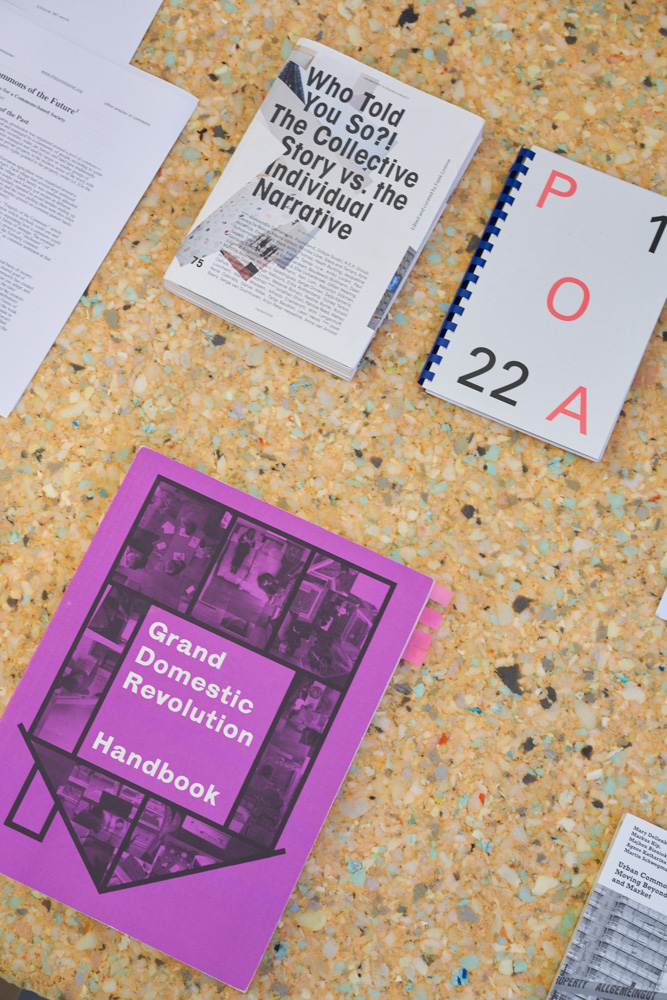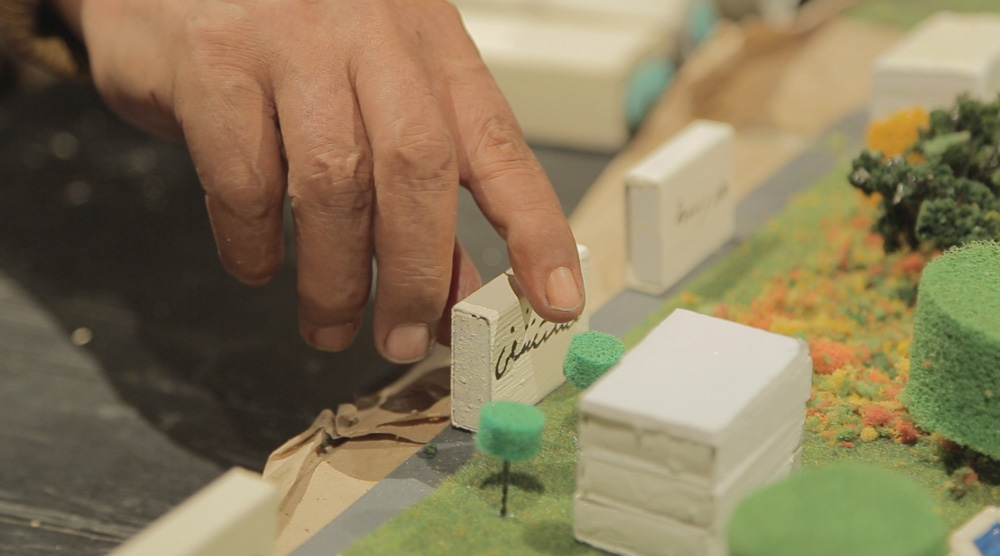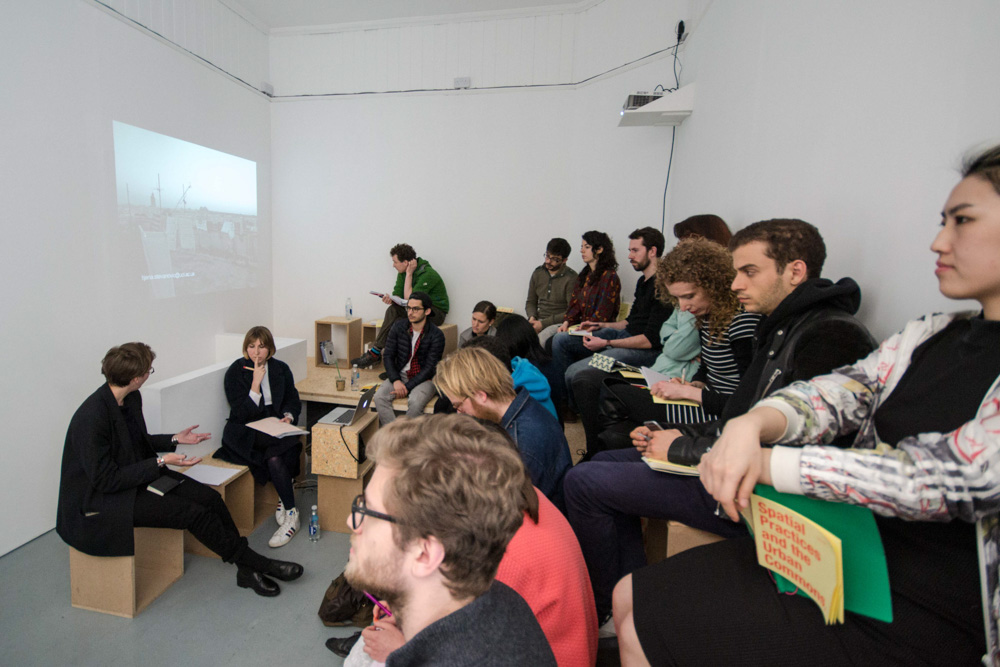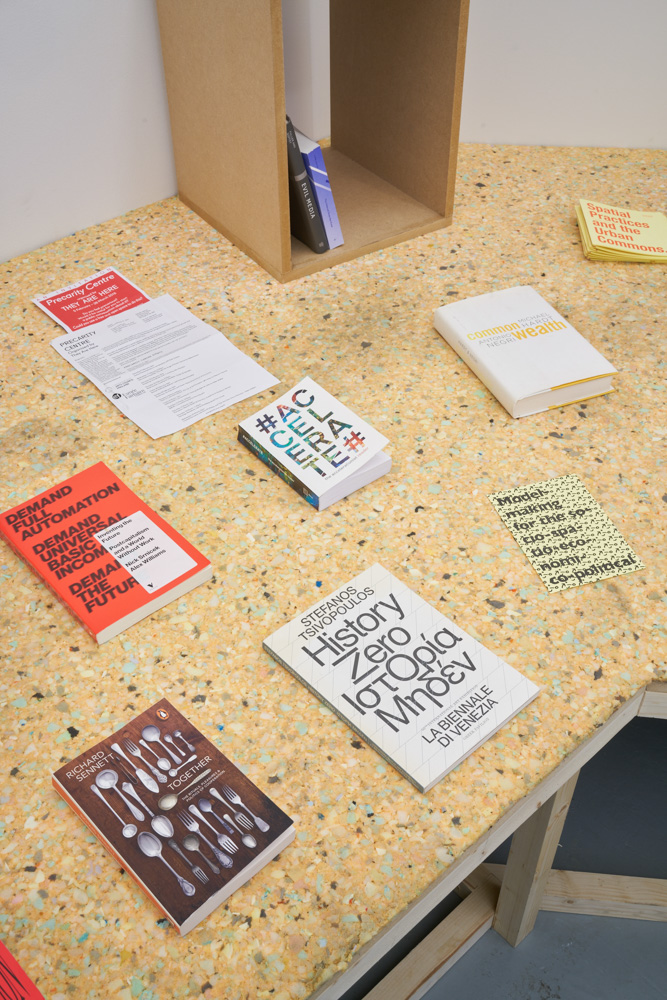Spatial Practices and the Urban Commons
Can Altay, Thomas Dobson, Fernando García-Dory, Sabel Gavaldon, Adelita Husni-Bey, Matthew Fuller, Platon Issaias, Tim Ivison, Just Space, Adam Kaasa, Josie McVitty, Godofredo Pereira, Emily Rosamond, Louise Shelley, Squash, Tijana Stevanović, Ben Vickers, Joanna Warsza
9 April until 4 June 2016, Tenderpixel, London, UK
The event series took shape in variety of formats, including talks, discussions, seminars, workshops, tours and publication launches. The gallery also hosted an exhibition, including a research library and a debate space on the ground floor, and a screening downstairs. Can Altay's ongoing journal, 'Ahali, Setting a Setting' unfolded into an installation, including new contributions. Adelita Husi-Bey's video ‘Ard’ (Land), 2014 presented a specific case study of ‘Cairo 2050’, a government-backed and privately funded metropolitan development plan of epic proportions, which threatens the livelihood of many settlements.
--
In the view of the recent unparalleled scale of urban expansion, issues of living together, the urban commons, and how to create discursive, agonistic, democratic spaces have become subjects of outstanding importance. In the past century, we have seen an ever-growing number of people move to the cities: more than half of the world’s population live there now, and continuously add to the sprawling margins of the urban settlements while also creating new ways of living. UN-Habitat estimates that by 2030 approximately 2 billion people will be living in ‘informal’, self-build communities, mostly without the basic infrastructure such as transportation, sanitation, running water etc.(2) To confront the distinction between formal and informal, it is important to address both as forms that come as a result of specific power relations and forms of governance.(3)
Architecture defines our modes of living together as a group, as a community, and in general as people in cities and of the globe. These varying degrees of togetherness (should) come with responsibilities. What kind of structures could enable us to have better life and communities?(4) Can we invent spaces in support of a form of political imagination?(5) We are particularly inspired by those structures and settings the commons create and take.
The commons will be one of the most important principles we will keep coming back to during this project. Many urban movements today have lost confidence in The State. The concept of the commons has been developed from an anti-capitalist standpoint, and against the effects of neoliberalism. It promises participatory self-governance, regaining control over the means of our own reproduction(6), and offers an alternative in a wide range of areas, including food and water supply, housing, public places, health-care, child and elderly care, and even scientific knowledge, climate change, wikipedias, cultural treasures, and so on.(7)
How can we enable and facilitate agonistic democratic discussions (to use Chantal Mouffe’s term)? This is in order to build a community, that is connected and has agency. This ideal community is able to produce new voices and conversations where people are able to debate issues, with a potential to also disagree with each other. Again, ideally, this format produces its own leaders that emerge from the community as intelligent instigators rather than specialists, and hence are non-affiliated (to political parties, companies or other loyalties), and can perhaps more effectively communicate the needs of a community. Participation and collaboration have become loaded and overused words, with a heavy criticism (for instance by Markus Miessen(8)). It is important to be able to think beyond this crisis of participation, and aware of its problems, create discussions, solutions and space beyond.
Architecture remains one of the most tangible ways of constructing the social.(9) Within this series, we are looking at case studies for traditional and designed cities, structures and communities. For instance the tradition of the diwaniya in Kuwait, which is most often a hall attached to the outside of private or public buildings, and is very much part of the urban structure. This is a place usually only reserved for men to receive their business colleagues and male guests. They discuss and exchange news and ideas on their local affairs. The speaker can subsequently communicate the accumulated knowledge and the results of the meetings at other gatherings. Diwaniyas are part of the informal political decision-making process across all levels of society, even members of parliament attend them. To bring the positive aspects of this model to the event series at Tenderpixel, the built structure on the ground floor of the gallery will mimic the diwaniya in order to facilitate discussions and create agency that will hopefully also continue beyond the remits of this season.
(1) 'Spatial Practice' is a term coined by Henri Lefebvre in The Production of Space, where he conceptualises three basic types of spaces: Lived Space, Perceived Space, and Conceived Space.
(2) Justin McGuirk, Activist Architects, Al Jazzera, 2014 justinmcguirk.com
(3) Platon Issaias talking about his dissertation, ‘Beyond the Informal City – Athens and the Possibility of an Urban Common’ www.uncubemagazine.com
(4) Can Altay, Introduction to Ahali: An Anthology for Setting a Setting, 2013
(5) Celine Condorelli, In Support, essay for Ahali: An Anthology for Setting a Setting, 2013, edited by Can Altay
(6) Silvia Federici
(7) Urban Commons. Moving Beyond State and Market. Edited by Mary Dellenbaugh, Markus Kip, Majken Bieniok, Agnes Katharina Müller and Martin Schwegmann
(8) Markus Miessen, The Nightmare of Participation, 2011
(9) Nikolaus Hirsch, Julieta Aranda, Brian Kuan Wood, Anton Vidokle, Editorial – Architecture as Intangible Infrastructure, Issue One www.eflux.com
--
Events Schedule
--
Editorial meeting
Saturday, 9 April, 4 until 8pm
This is a closed event for the event contributors only. During this workshop we pose questions, and speculate about a better future. We try and establish common grounds, define notions and general rules we adhere to during the event series, while the outcome of the discussion will contribute towards the publication that will accompany the events.
--
Forms of Commoning in London
Friday, 22 April, 6.30 until 8.30pm
This cluster of talks brings together various London based organisations and initiatives that work with specific communities and question what does better conditions mean in terms of politics of urban culture today.
Louise Shelley is Collaborative Projects Curator at The Showroom. She has coordinated the Communal Knowledge programme since 2010, a series of collaborative projects with local and international artists for critical engagement with gallery’s social and cultural surroundings. NW8 is known for its distinctive and diverse communities from across the Middle East and Africa. Culturally rich, the neighbourhood also has the 4th lowest median household income of all the wards in London. Through the projects the emphasis has been on finding ways to re-think or ‘unlearn’ established codes and relations, to create visibility, and to produce alternative knowledge through communal activity. LINK TO VIDEO
Adam Kaasa (Theatrum Mundi, London School of Economics) is an interdisciplinary scholar who specialises in the politics of the city, foregrounding the role of architecture and design. He is director of Theatrum Mundi, a professional network of urbanists and artists that offers a forum for cross-disciplinary discussion about practices relating to cultural and public space in the city. He is a Research Fellow in Architecture at the Royal College of Art, completed his PhD as a SSHRC Scholar at the London School of Economics and is a founding member of When We Build Again. LINK TO VIDEO
Thomas Dobson (public works). The Public(s) Land Grab is a live research project which takes a stance against the inequalities intrinsic to capital-led urban development. As developers become increasingly irresponsible we question whether residents can re-appropriate development as a tool to level social inequalities and reclaim land and resource for public benefit? Like most citizen-led initiatives in London at the moment this starts with a community garden: the Loughborough Farm in Loughborough Junction, South London. LINK TO VIDEO
--
The Public(s) Land Grab - On the ground with Thomas Dobson
Saturday, 23 April, 12.30 until 3pm
Meeting at Loughborough Farm, Loughborough Junction, South London
Get your hands dirty on the common. Step away from the laptop and join the Loughborough Farm. This farm is an urban common in practice, self-initiated, self-governed and self-funded by volunteers. It aims to reconnect residents with processes of production, from food growing and DIY to sourcing land and funding - all processes that have become alien concepts in a consumption focused society.
--
Can Altay: Ahali, Journal Launch and Private View
Friday, 29 April, 7 until 9pm
PV for the exhibition 'Spatial Practices and the Urban Commons' with Adelita Husni-Bey and Can Altay, and launch of Can Altay's journal, Ahali, Setting a Setting.
--
Beyond Formal and Informal Structures
Saturday, 30 April, 2 until 6pm
This cluster of talks will present case studies from around the world to show examples of the permeability of ‘informal’ and ‘formal’ architecture and systems of governance.
Josie McVitty is an urban development specialist with a focus on policy and investment for affordable housing and infrastructure delivery in rapidly growing urban environments. In recent years she has worked on city support programmes with the World Bank in Jakarta, Indonesia; on strategies for sustainable financing of neighbourhood improvement in Haiti, and on research and advisory in Nigeria, Morocco, Tunisia and Vietnam, among other countries. She is currently based in South Africa, as a consultant to International Housing Solutions. Based on these experiences, her talk will focus on interventions that have bridged the gap between informal urban processes and formal systems, and provide examples of how community-led development can be harnessed in the design of government programmes to enhance their impact and sustainability.
Platon Issaias is an architect. He holds an MSc in Advanced Architectural Design from GSAPP, Columbia University and a PhD from TU Delft. Since 2015 he has been teaching Architecture at the Royal College of Art, London, and prior to that since 2012 Urban Design at The Bartlett School of Architecture University College London. He will talk about his doctoral dissertation, ‘Beyond the Informal City’, and discuss ‘informal’ urbanisation that characterises the contemporary Greek cities and their urban typologies and protocols. Athens in particular will offer a case study and possible critique on the recent conceptions regarding the distinction between ‘informal’ and ‘formal’ urbanism.
Tijana Stevanović is currently writing her PhD at Newcastle University on relations of Yugoslav workers’ self-management to the transformation of architectural practice in post-war New Belgrade. She is a Teaching Fellow at the Bartlett School of Architecture, University College London and a Lecturer in Interior Architecture and Design, Theory and Practice at the University for Creative Arts. She initiated several collective projects which commonly explored the systems of knowledge classification and institutionalisation of critique in art production processes. Recent ones, developed and exhibited in Newcastle and Berlin are: I am too sad to dissent (2013), A Partial Index (2014) and Sick Leave (2015).
Tim Ivison is an artist and researcher based in Los Angeles. He is currently writing up a PhD dissertation on biopolitics in urban planning at the London Consortium, a multidisciplinary program based at Birkbeck College, University of London, where he studied under Mark Cousins. Ivison is a 2014-2016 Andrew W. Mellon Foundation Researcher at the Canadian Centre for Architecture and teaches Cultural Studies at the Southern California Institute of Architecture, Los Angeles. His talk will focus on the 1970s redevelopment of certain areas of central London, and it’s public opposition.
Joanna Warsza is curator, researcher, writer in the fields of visual and performing arts and architecture. Her practice centres around social and political agendas, such as the invisibility of the Vietnamese community in Warsaw, Israeli youth delegations in Poland, and the legacy of post-Soviet architecture in the Caucasus. Currently she is a head of the curatorial program CuratorLab at Konstfack in Stockholm. Among others she curated the Public Program of Manifesta 10 in St. Petersburg; Kamikaze Loggia, Georgian Pavilion at the 55th Venice Biennale and she was associate curator of the 7th Berlin Biennale. She edited of Stadium X-A Place That Never Was (2009), Forget Fear (2012) and Ministry of Highways: A Guide to the Performative Architecture of Tbilisi (2013).
--
Convention on the Use of Spacewith Adelita Husni-Bey and London based radical housing groups Just Space and Squash
Saturday, 7 May, 4 until 7pm
In our 3 hour session, after short introductions from keynote participants / speakers, we will take a close look at the Convention on the Use of Space. The ‘Convention on the Use of Space’ is a legal instrument publicly drafted between March and May 2015 through IRL meetings in the Netherlands as a response to the housing crisis: the lack of affordable homes, absence of provisions for those without legal right to stay, rising rents, and the criminalisation of squatting. In reading the document we will analyse what the convention’s claims are and how it could be used / adapted to a UK context. To do this, we will use a seminar format, where we will collectively read the document and propose amendments and notes which will go towards a future UK version of the convention to be produced in 2017/2018. This event is for you if you’re interested in 'movement-perspective legislation', commoning and grassroot organising!
Adelita Husni-Bey is an artist whose practice involves the analysis and counter-representation of hegemonic ideologies in contemporary Western societies. Recent projects also focus on rethinking radical pedagogical models within the framework of anarcho-collectivist studies. She has shown and collaborated with a number of institutions such as: Caso (2015); Reina Sofia Museum, Madrid (2014); Maxxi Museum, Rome (2014); Gasworks, London (2012); and NBK, Berlin (2013). She completed the Whitney Independent Study Program, New York in 2012 and was an artist-in-residence at Kadist Art Foundation, San Francisco in the fall of 2015.
--
An Urban Bestiary with Sabel Gavaldon
Saturday, 14 May, 4 until 6pm
Animals are powerful attractors that collect the hopes, anxieties, and interests of collectives. The histories of many species living among us are tied to the transformations brought on by the industrial revolution and the emergence of new minorities invented in the 19th Century. From then on, urban wildlife and pest control are involved in an intimate relationship with urban planning and the administration of prostitution, pathology, and political agitation. This bestiary will explore the manifold ways in which urban life is entangled with the biopolitical histories of all kinds of animals, from the role played by mosquitos in enforcing spatial segregation in Congolese cities under colonial rule, to the co-evolution of French bulldogs and lesbians in 19th-Century Paris, to the Occupy protesters being portrayed as parasites by the Daily Mail. Opportunistic species including rats, pigeons, flies, bedbugs, and cockroaches thrive in the interstices of the city, despite being universally shunned by humanity — a testament to irrepressible life, reappropriating hostile terrain. These animals are powerful biopolitical figures, which have played an instrumental role in the control of human populations. And yet, it is time to regard them as biocultural companions, ready to yoke unlikely partners into new ways of surviving together.
Sabel Gavaldon is an independent curator and researcher based in London. Recent projects include Axolotlism, at Nogueras Blanchard, Madrid (2015); M/Other Tongue, at Tenderpixel, London (2015); Llocs comuns at Can Felipa, Barcelona (2014); and A Museum of Gesture, at La Capella, Barcelona (2013). At present, he is co-organising the curatorial laboratory, Komisario Berriak, within the San Sebastian European Capital of Culture programme 2016.
--
Ecologies
Saturday, 21, May, 3 until 6pm
To think ecologically is not so much a matter of protecting existing ecologies, but more importantly, a matter of generating conditions for different ones to emerge and affirm themselves. In this cluster we will look at architecture as a practice that has the ability to give consistency, or even to formalise certain modes of living.
Fernando García-Dory’s collaborative projects involve using art as a means to precipitate social change, often addressing attitudes towards food production, community and tradition. His projects frequently involve creating a working platform or stage for meetings and discussions on the current situation of a particular aspect of land use or other farming related issue. He is interested in the process of building sustainable communities through collaborative and discursive agro-ecological projects, actions, and cooperatives. Interested in the harmonic complexity of biological forms and processes, his work addresses connections and cooperation, from microorganisms to social systems, and from traditional art languages such as drawing to collaborative agroecological projects, actions, and cooperatives. His multi-faceted projects investigate the notion of art as a tool or tactic for action with communities, with a focus on projects involving science and technology or driven by ecological concerns.
Platon Issaias and Godofredo Pereira's talk will be expanded from the studio they teach on the MA Architecture course at the RCA, titled Ecologies of Existence – Architecture and Modes of Living. They are interested in various aspects of living, from emerging modes of production, to types of social organisation, of inhabitation or relations to nature, that do not conform to the ossification of social structures, familial relations and psychological imaginaries inherent to neoliberal forms of urban development. What is the role of architecture in giving both material and social consistency to these processes? How can we provide spaces for events to happen by formalising a specific program, or giving visibility to certain communities and their modes of living? In their view, architecture gains its political relevance precisely when it is able to think space and its configurations in terms of living. And it is in this sense that they argue that architecture is a significant category of ecological struggle.
--
Abstract Cities
Saturday, 4 June, 4 until 7pm
This cluster of talks will look at how computational processes influence the way we navigate and live in the urban environment – including predictive algorithms, data structures, and other manifestations of power and control. The present will be revealed and the future re-designed.
Matthew Fuller is director and professor of the Centre for Cultural Studies, at Goldsmiths, University of London. He is involved in a number of projects in art, media and software. He is the author of Media Ecologies: Materialist Energies in Art and Technoculture (MIT Press), Software Studies (MIT Press), and with Andrew Goffey of Evil Media (MIT Press). For this event, Fuller will look at the way in which computation folds into urban space, and how data-structures merge with, redistribute, produce and arrange the city and the perceptual, political and aesthetic dimensions that go with it.
Emily Rosamond is a Canadian artist, writer and educator. She is a Lecturer in Fine Art at the University of Kent, and a member of the art collective School of The Event Horizon. She completed her PhD in Art in 2016 at Goldsmiths, University of London, where she held a Commonwealth Scholarship. Her doctoral work focused on character as a prominent speculative, representational logic of personhood in an era of predictive analytics. Often, such analytics (associated with big data) focus on determining individuals’ future actions by analysing their past behaviour, or statistically situating them within flows of transient norms in social networks.
Ben Vickers is the curator of digital at Serpentine Gallery. As a curator, writer, network analyst, technologist and luddite he is at the forefront of new developments of online art and culture. He is one of the initiators of the unMonastery, a community-based social innovation project in Matera, Italy, addressing the interlinked needs of empty space, unemployment and depleting social services by embedding committed, skilled individuals within localities that could benefit from their presence. His practice centres around how systems of distribution, both human and other, come to affect our personal perception of reality.
































